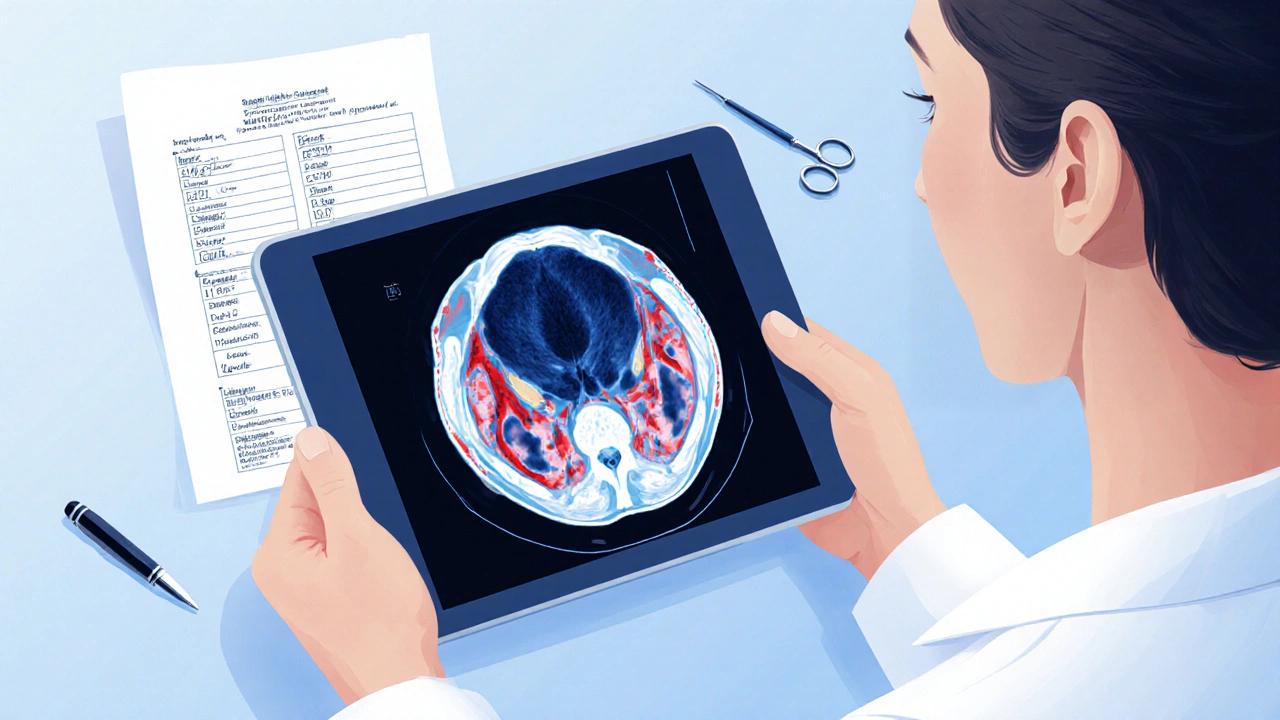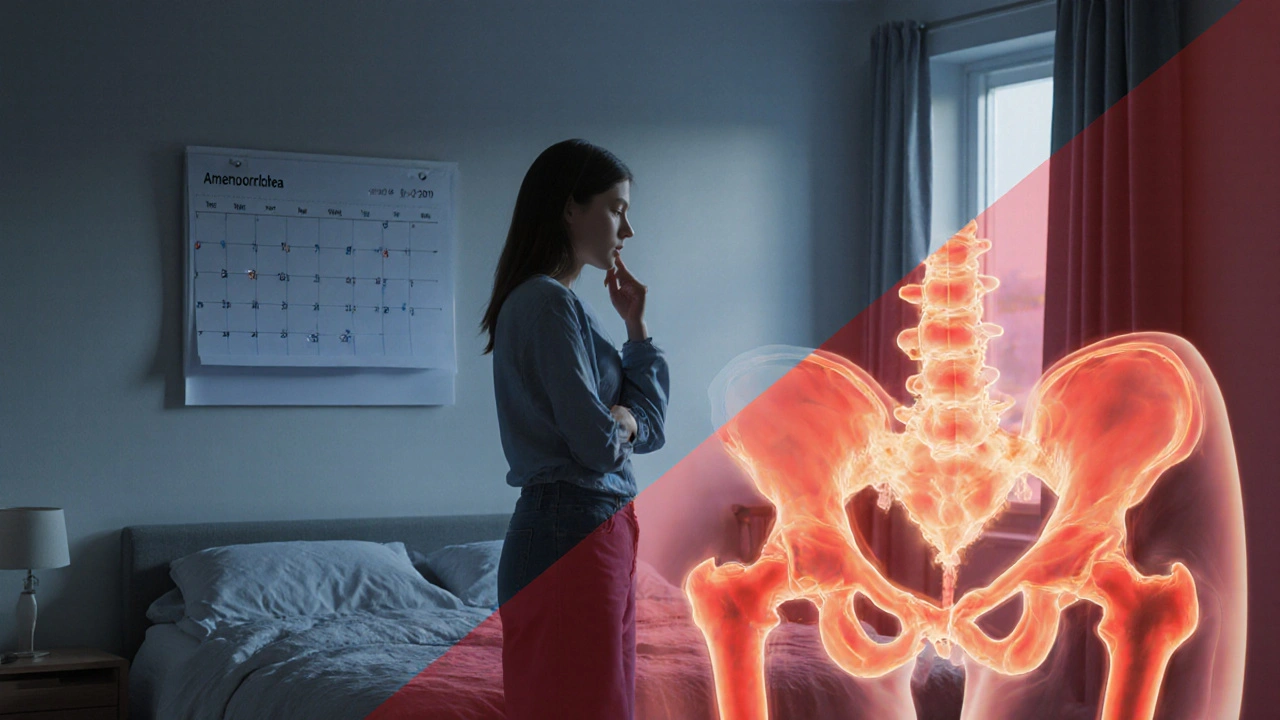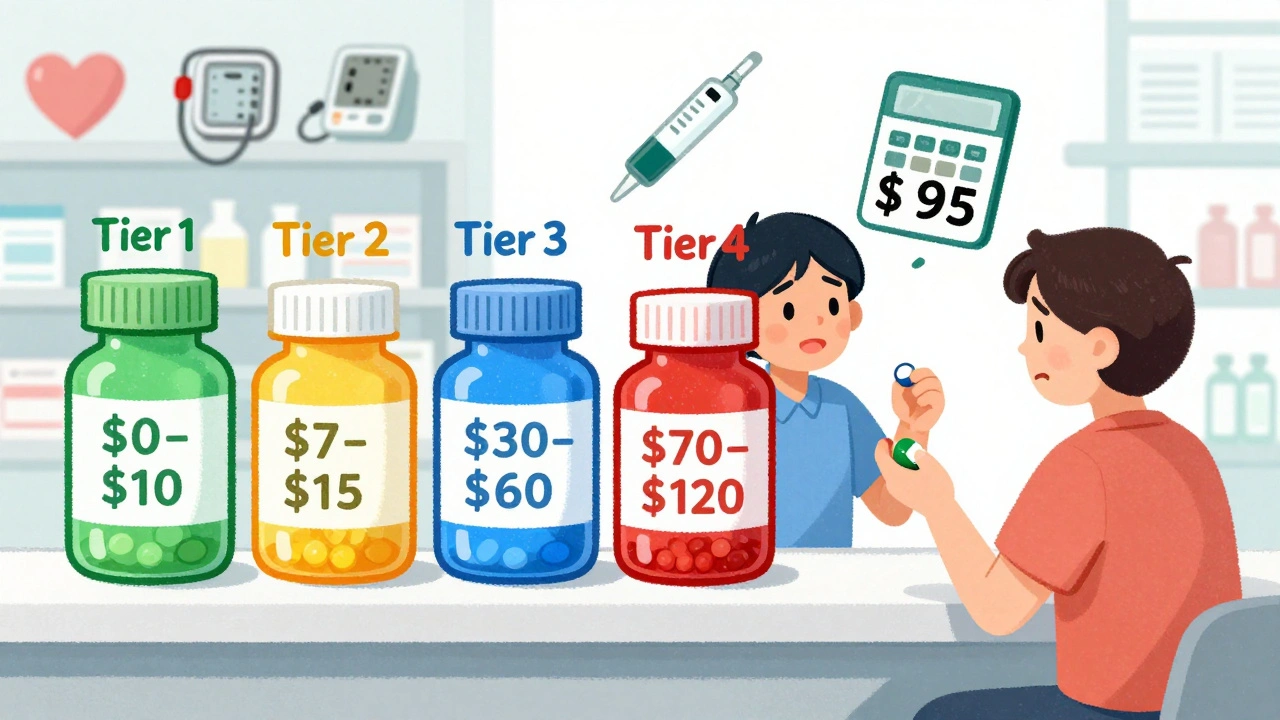Amenorrhea & Endometriosis Symptom Checker
Check all symptoms that apply to your situation. This tool helps identify potential links between amenorrhea and endometriosis.
Analysis Results
Imagine missing periods for months, then suddenly developing painful, heavy periods that don’t go away. It feels like two opposite problems colliding, but for many women they’re two sides of the same hormonal coin. Understanding amenorrhea and endometriosis together can clear up confusion, speed up diagnosis, and point to treatment that tackles both issues.
Quick Takeaways
- Amenorrhea (absence of periods) can be a warning sign of hidden endometriosis.
- Both conditions share hormonal imbalances, especially low estrogen and disrupted GnRH signaling.
- Pelvic pain, infertility, and irregular spotting are common red flags.
- Imaging (MRI) and laparoscopy are the gold standards for confirming endometriosis.
- Combined medical therapy (hormonal contraceptives, GnRH agonists) and lifestyle changes often work best.
What Is Amenamenorrhea?
Amenorrhea is defined as the complete absence of menstrual bleeding for three consecutive months in women who previously had regular cycles, or for twelve months in adolescents who have never started menstruating. It signals a disruption in the hormonal axis that controls the uterine lining. The condition splits into two main types:
- Primary amenorrhea: No period by age 15 despite normal growth.
- Secondary amenorrhea: Periods stop after having been established.
Common triggers include extreme weight loss, intense exercise, chronic stress, thyroid disorders, polycystic ovary syndrome (PCOS), and, surprisingly, undiagnosed endometriosis.
What Is Endometriosis?
Endometriosis is a chronic gynecological disease where tissue similar to the uterine lining (endometrium) grows outside the uterus, most often on the ovaries, pelvic peritoneum, and uterosacral ligaments. These ectopic implants bleed each month, causing inflammation, scar tissue, and pain. Estimates suggest that 1 in 10 women of reproductive age are affected, but many remain undiagnosed for years.
Key symptoms include:
- Pelvic or lower‑back pain that worsens around menstruation.
- Dyspareunia (painful intercourse).
- Heavy or irregular bleeding.
- Infertility.
How Can Amenorrhea Signal Hidden Endometriosis?
At first glance, missing periods and painful periods seem unrelated. The link lies in hormonal feedback loops. Endometriotic lesions produce local estrogen and inflammatory cytokines that can suppress the hypothalamic‑pituitary‑ovarian (HPO) axis. When the body perceives chronic inflammation, it may reduce gonadotropin‑releasing hormone (GnRH) pulses, leading to lower luteinizing hormone (LH) and follicle‑stimulating hormone (FSH) levels. The result? Ovarian follicles don’t mature, estrogen drops, and menstruation stops.
Conversely, women with functional hypothalamic amenorrhea (often from low body fat or stress) may have reduced systemic estrogen, which can paradoxically allow dormant endometrial implants to grow unchecked because the protective effect of cyclic shedding is lost.
In practice, clinicians see three patterns:
- Secondary amenorrhea after years of painful periods: The pain persists, but bleeding ceases as estrogen wanes.
- Amenorrhea in athletes with pelvic pain: Intensive training masks classic endometriosis signs, delaying diagnosis.
- Primary amenorrhea with imaging evidence of endometriosis: Rare, but ectopic lesions can disrupt normal uterine development.

Key Clinical Clues to Watch For
When a patient presents with amenorrhea, ask targeted questions to uncover hidden endometriosis:
- Do you experience chronic pelvic or lower‑back pain, even when you’re not menstruating?
- Has intercourse ever been painful?
- Do you notice any spotting, brown discharge, or occasional bleeding?
- Have you tried to conceive without success?
- Is there a family history of endometriosis or menstrual disorders?
Physical examination may reveal tender nodules in the posterior fornix or limited uterine mobility, both hints of deep infiltrating disease.
Diagnostic Pathway
Diagnosing endometriosis in the context of amenorrhea requires a stepwise approach:
- Laboratory assessment: Measure serum estradiol, LH, FSH, prolactin, and thyroid‑stimulating hormone (TSH). Low estradiol (<30pg/mL) supports functional amenorrhea, while elevated inflammatory markers (CRP, IL‑6) may point to endometriosis.
- Imaging: Transvaginal ultrasound can detect ovarian endometriomas, but MRI offers superior visualization of deep infiltrating implants, especially when menstrual bleeding is absent.
- Laparoscopy: The definitive test. Surgeons can directly see and biopsy lesions, confirming diagnosis and allowing immediate treatment.
Because laparoscopy is invasive, many clinicians reserve it for patients with strong symptom clusters or infertility concerns.
Treatment Strategies That Address Both Issues
Therapies aim to restore normal hormonal cycling while suppressing ectopic endometrial growth.
- Hormonal contraceptives: Combined oral contraceptives (COCs) provide cyclic estrogen and progestin, re‑establishing endometrial shedding and reducing lesion activity. For women with severe pain, continuous‑use COCs eliminate withdrawal bleeding and offer steady hormone levels.
- GnRH agonists or antagonists: Drugs like leuprolide create a temporary menopausal state, shrinking lesions. However, they also suppress natural estrogen, potentially worsening amenorrhea unless a “add‑back” low‑dose estrogen‑progestin is prescribed.
- Progestin‑only options: Levonorgestrel intrauterine system (LNG‑IUS) releases local progestin, thinning the endometrium and reducing pain without systemic estrogen fluctuations.
- Metformin: Particularly useful in women with concurrent PCOS, it improves insulin sensitivity, boosts endogenous estrogen, and may indirectly reduce lesion burden.
- Lifestyle modifications: Adequate caloric intake, stress‑reduction techniques (mindfulness, yoga), and moderate exercise can normalize HPO axis signaling, helping periods return while also decreasing inflammatory cytokines associated with endometriosis.
In severe cases, surgical excision of endometriotic implants during laparoscopy can restore pelvic anatomy and improve fertility prospects, but surgery alone rarely resolves amenorrhea without concurrent hormonal therapy.
When to Seek Specialist Care
If you experience any of the following, schedule a visit with a gynecologist or reproductive endocrinologist:
- Missing periods for more than three months accompanied by persistent pelvic pain.
- Infertility after trying for six months (or twelve months if over 35).
- Significant pain during intercourse or bowel movements.
- Family history of endometriosis or unexplained infertility.
Early specialist involvement can shorten the diagnostic delay-currently averaging 7‑10 years for endometriosis-and improve long‑term outcomes.
FAQs
Can amenorrhea be the first symptom of endometriosis?
Yes. While painful periods are the classic sign, some women develop chronic pelvic pain and then lose their cycles because the disease interferes with estrogen production. Recognizing pain patterns alongside missed periods can prompt earlier testing.
Is it safe to use birth control pills if I have endometriosis‑related amenorrhea?
Birth control pills are often the first line of therapy. They restore estrogen levels, help re‑establish regular bleeding, and shrink endometriotic lesions. Your doctor may recommend a continuous‑use regimen to keep hormone levels steady.
What role does diet play in managing both conditions?
Anti‑inflammatory foods (omega‑3 rich fish, leafy greens, nuts) can lower cytokine levels that fuel endometriosis. At the same time, adequate calories and healthy fats support estrogen synthesis, helping to break the cycle of functional amenorrhea.
How effective is laparoscopy for diagnosing endometriosis when periods are absent?
Laparoscopy remains the gold standard. Even without menstrual bleed, surgeons can visualize lesions, take biopsies, and often treat them in the same session. Success rates for confirming disease exceed 90% when performed by experienced gynecologic surgeons.
Can I become pregnant after treating both amenorrhea and endometriosis?
Most women regain ovulatory cycles within 6‑12 months of combined hormonal therapy or surgical excision. Fertility rates improve dramatically-up to 60% conceive naturally within two years when both conditions are managed effectively.
Understanding that amenorrhea and endometriosis often walk hand‑in‑hand turns a confusing symptom pair into a clear treatment target. By recognizing the hormonal overlap, seeking timely evaluation, and embracing a mix of medical, surgical, and lifestyle approaches, many women reclaim regular cycles, relieve pain, and boost their chances of a healthy pregnancy.








Brittaney Phelps
October 3, 2025 AT 16:00Missing periods while dealing with endo pain? Get checked ASAP!
Kerri Burden
October 5, 2025 AT 09:40The intersection of hypothalamic‑pituitary‑ovarian axis suppression and ectopic endometrial implants creates a pathophysiological milieu where amenorrhea may masquerade as a benign endocrine anomaly. Clinicians should employ serum estradiol profiling alongside transvaginal ultrasonography to delineate occult disease. Moreover, MRI‑based mapping of deep infiltrating lesions can preempt delayed diagnosis.
Joanne Clark
October 7, 2025 AT 03:20One must first acknowledge the epistemic chasm that separates layperson perception from the intricate endocrinological choreography governing menstrual homeostasis. When amenorrhea ensues, it is not merely a "forgotten period" but often a sentinel event heralding dysregulation of GnRH pulsatility, a phenomenon meticulously documented in the seminal works of Barbieri et al. (1999).
Concomitantly, the insidious advent of endometriotic lesions engenders a localized estrogenic crucible, perpetuating a paradoxical state wherein systemic estradiol wanes whilst tissue‑specific estrogen synthesis persists. This dichotomy precipitates a feedback inhibition of the hypothalamic‑pituitary axis, culminating in the cessation of ovulatory cycles.
Moreover, the inflammatory cytokine milieu-IL‑6, TNF‑α, and prostaglandins-exerts neuroendocrine interference, dampening LH surges essential for follicular maturation. The resultant anovulation manifests clinically as secondary amenorrhea, a nuance often overlooked by practitioners fixated on overt pelvic pain.
It is imperative, therefore, to adopt a multimodal diagnostic algorithm: initial hormonal panel (estradiol, LH, FSH, prolactin, TSH), followed by high‑resolution pelvic MRI to visualize deep infiltrating endometriosis, and, when indicated, diagnostic laparoscopy with histopathological verification.
Therapeutically, a dual‑pronged approach employing GnRH agonists to suppress ectopic lesion activity, coupled with cyclic hormonal contraception to re‑establish endometrial shedding, has demonstrated superior outcomes in randomized controlled trials.
In sum, amenorrhea should be regarded as a potential harbinger of concealed endometriosis, warranting comprehensive evaluation rather than simplistic reassurance.
Neglecting this interplay not only delays definitive care but also predisposes patients to infertility, chronic pain, and diminished quality of life. Definately, a more nuanced appreciation of this relationship will refine clinical practice and improve patient prognoses.
George Kata
October 8, 2025 AT 21:00Great synthesis-just a couple of quick notes. While the pathophysiology you outlined is spot on, remember to double‑check spelling of "definately" (it’s "definitely"). Also, adding a brief mention of lifestyle modifiers like stress management can make the guidance even more practical for patients.
Nick Moore
October 10, 2025 AT 14:40It’s encouraging to see the focus on both hormonal therapy and surgery. Many patients feel overwhelmed, so framing the treatment plan as a partnership really helps. Keep highlighting the importance of mental health support alongside the medical interventions.
Jeffery Reynolds
October 12, 2025 AT 08:20Absolutely, a collaborative approach is essential. Evidence shows that combined GnRH agonists with add‑back therapy reduce bone loss while controlling lesion growth. Patients should also be advised about potential side‑effects and the need for regular follow‑up.
Mitali Haldankar
October 14, 2025 AT 02:00Endo + no period? 😕🤔
snigdha rani
October 15, 2025 AT 19:40Oh sure, because ignoring a serious health issue is always the best plan. 😂 In reality, missing periods while hurting is a red flag, not a minor inconvenience. Grab a doctor before you start binge‑watching shows to forget about it.
Mike Privert
October 17, 2025 AT 13:20Staying proactive is key. Encourage regular check‑ups and remind patients that early intervention can spare years of unnecessary discomfort. A supportive environment makes a huge difference in adherence to treatment.
Chris Faber
October 19, 2025 AT 07:00totally agree its all about early detection and not waiting till stuff gets worse guys its better to get it sorted early